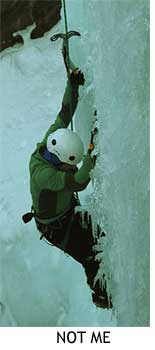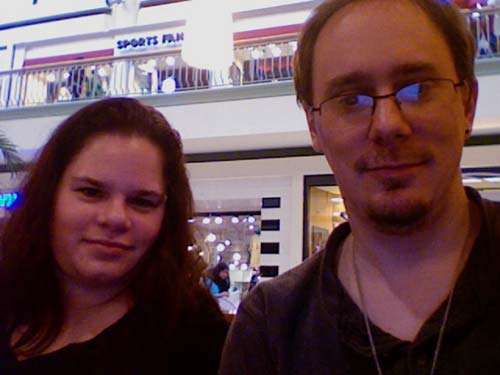What you are about to read is a true story. It is a tale of adventure, and courage, and horror, and as such it may not be appropriate for the sensitive. Adults should take young children by the hand, and make sure their arms and legs remain in the ride at all times. Brace yourself, for this tale contains scenes of such horror and woe as to make a grown man weep. You have been warned.
I live in a sleepy little suburb of Atlanta called Duluth. Folks hereabouts value peace and quiet, and not much happens here. Life is quiet, and horror rarely visits this place, save during Presidential elections. About the most exciting thing that happens ’round these parts is the occasional referendum against extending Atlanta’s mass transit system into Duluth…but more on that later.
I live in a small apartment in this sleepy little community, a domicile which is, alas, filled with the detritus of a life of adventure in far corners of the globe. Ancient relics of long-forgotten computers and other prized trophies of a misspent youth fill my living space to overflowing, and with Shelly’s recent move to Tallahassee, where she has precious little space for storing things, my apartment has filled even more.
A couple of weeks ago, Shelly came up to visit, and brought with her such artifacts and relics as I had been keeping in storage with her. Owing to the aforementioned cramped living space I have here, we had little choice save to begin storing some of these legendary artifacts on my balcony.
I have two cats, as regular readers of this journal will no doubt recall. Now my cats, in keeping with the nature of cats everywhere, love little more than to sit in the window and observe the various daily activities of Man and beast as they go by below. The cats particularly love to spend their leisure time in front of the sliding glass door to the balcony, and watch the squirrels leaping about in the skeletal husks of the undead zombie trees outside.
When I first moved to Duluth, the vista offered from the vantage of my balcony was lovely indeed, a stunning panorama of deep forest beyond the apartment complex. Lovely, but fraught with the hints of impending doom, for the trees were…wrong, somehow. The leaves, which should be bright green, were changing, becoming monstrous, turning to sickly hues of yellow and red; within weeks, they began falling from the trees, leaving only the dry bones of skeletal trees.
The denizens of Duluth took this strange and foreboding change in stride. This happens regularly, I was told, every year like clockwork; the trees seemed to the casual observer to be dead, but were actually in a state beyond death, sleeping like the Great Old Ones until the day the stars were right for their return to life. In the spring, they said, the trees would return to life, and roll away the stone to the salvation of us all, or stalk the countryside in search of human blood to feed their zombie reanimation, or some such thing, and that all of this was a part of God’s promise of renewal.
So we see how even the most horrific of things can in time become normal. Humans are a curiously adaptable species.
But I digress.
 As I was saying, Shelly’s arrival precipitated the need for storing many of my ancient and hoary treasures on the balcony. Shelly slid open the balcony doors, and a thunderbolt of realization struck our cats, particularly Snow Crash, the more flighty and impressionable of the two. “Holy Mother of God!” he said. “You mean there’s another room out there??! Why was I not informed of this??? I insist, mortal human, that you allow me out there at once!”
As I was saying, Shelly’s arrival precipitated the need for storing many of my ancient and hoary treasures on the balcony. Shelly slid open the balcony doors, and a thunderbolt of realization struck our cats, particularly Snow Crash, the more flighty and impressionable of the two. “Holy Mother of God!” he said. “You mean there’s another room out there??! Why was I not informed of this??? I insist, mortal human, that you allow me out there at once!”
Or perhaps that is what he would have said, had he been gifted with the power of speech.
In any event, it should suffice to say, gentle reader, that the cats were fascinated by the discovery that this huge pane of glass was in fact a doorway to places unknown, and they immediately made the exploration of this strange portal the utmost priority.
This is the setting of my tale. The tale itself begins three nights ago, when I returned from a long day’s toil to my humble abode, cluttered as it was with the possessions of my lifetime, and took it upon myself to bring to the chaos some semblance of order. To this end, I began moving things from my living room to the balcony, where I could later properly catalogue them and decide upon their future disposition.
I slid open the door to the balcony, nimbly evaded the frantic attempts of the cats to dash through the opening during this narrow window of opportunity, and closed the door behind me scant millimeters from their pink wet noses.
In that moment, the horror began, though at this point I was as yet unaware of the trials that awaited me.
With my task on the balcony complete, I turned to open the door, and discovered to my surprise and dismay that it appeared to be stuck. “Oh, great,” I thought, “it’s being stubborn. I’ll have to wiggle it open.”
I tugged, pried, wiggled, and yes, gentle reader, even kicked the door, to no avail. A chill seeped into my bones, as I realized that I had closed the door with such vigor that the lock had latched itself, and I was now trapped on the balcony with no means of egress available save for a long plummet to what would most undoubtedly be a grisly demise at the feet of the unliving trees.
I did not yet panic, however. I have endured many trials and adventures at the hands of an uncaring fate, and I felt supreme in my ability to prevail over this misfortune. I renewed my attack on the balcony door with great vigor, pulling and prying and even jiggling it on its track in my efforts to open it.
All came to naught; the door stubbornly resisted me.
Nights in Atlanta are harsh and unforgiving. As time passed, the temperature plummeted into the high fifties. A howling gale, easily two or three miles per hour, began, and the icy wind brought the temperature into the mid fifties or worse. I had only a heavy winter jacket to protect me from the elements, and feared for my survival.
The sliding glass door taunted me, offering me a vision of safety and warmth denied me by only a single pane of glass. I renewed with even greater vigor my assault on the door. On the other side, the cats watched me, and I could almost hear their voices taunting me.
I have known many brave men–noble, strong men, to a one–who have confronted the unknowable mysteries of the Great Cthulhu and the other Old Ones, and one by one succumbed to madness, their corruptible human minds slowly eroded by the horrors they had witnessed and experienced until at last they were reduced to gibbering imbeciles, spending the last days of their lives imprisoned deep within asylums for the insane.
The wind grew stronger and, confronted with the horror of my own situation, I feared my own descent into madness had begun.
The mocking stares of the two cats pressed heavily upon me. I cast my mind about frantically, hoping to chance upon some idea that might free me from my lofty prison and return me to the safety and sanity of a normal life.
 I know! A rope! Surely, if only I had a rope, I could climb down from this accursed balcony and be free! I thought.
I know! A rope! Surely, if only I had a rope, I could climb down from this accursed balcony and be free! I thought.
With that vision to guide me, I began to search through the boxes and parcels stacked high in my prison. And to my great wonder, I found in a large and otherwise unremarkable box, a long coil of smooth white rope. Salvation!
With trembling hands, I made fast one end of the rope to the beam supporting the roof above me. I climbed over the rail of the balcony, and perched precariously on its edge, the free end of the rope in my hand. It was at this moment I realized the folly of my thoughts.
I do not know to this very day, gentle reader, what had possessed me to believe a rope could possibly save me. For you see, I am a pervert; I can use rope to tie people up in all manner of strange and wondrous ways before working my will upon them. I am not, however, Sir Edmund fucking Hillary, or James Bond, or any other person who might use a rope to climb down from a balcony.
I stood there for a time, balancing on the rail with a rope in my hand, and knew the unshakable truth: my position was not one whit improved.
 Even in the darkest night, there can sometimes shine a glimmer of light. Within the whirlwind of my despair, a tiny flicker of memory asserted itself: figment_j was due at my domicile that evening, as we had previously made a dinner engagement. I resolved to hunker down, sheltering myself as best I could from the fierceness of te elements, and wait it out, hoping that rescue would soon come.
Even in the darkest night, there can sometimes shine a glimmer of light. Within the whirlwind of my despair, a tiny flicker of memory asserted itself: figment_j was due at my domicile that evening, as we had previously made a dinner engagement. I resolved to hunker down, sheltering myself as best I could from the fierceness of te elements, and wait it out, hoping that rescue would soon come.
And arrive it did, almost before I could even have dared hope, before I had surrendered any body parts to frostbite. Se stood below me, bathed in radiant light, and a plan began to form.
I resolved upon a course of action which, though fraught with peril, might ultimately lead me from my dreadful perch. As I explained my plan, her eyes widened in shock and fear, but she summoned reserves of courage from somewhere deep inside and agreed to my proposal. I would, i explained, toss my keys down to her, so that she might walk around to my front door, open it, and let me in.
Now came the most delicate moment. The plan rested on the most fragile hope. I withdrew my keys from where they lay in my pocket, and took a deep breath. The slightest of miscalculations, or a chance gust of wind at the wrong moment, and she might not catch the keys, leaving them to fall to the ground in the darkness. I steeled myself, sent a brief silent prayer of good fortune to whatever supernatural beings might be making their silent way overhead on any of the various mysterious errands that bring them on occasion from the nether realms, and released my keys, sending all my hopes and fears with them toward her waiting hands.
The plan succeeded! She caught the keys effortlessly. At last, I thought, I am free!
But it could not be so easy.
The horror of the night peeled back layer upon layer, like the skin of an onion–a horror onion, made of horror.
Duluth, Georgia, is not quite the quaint and charming place it might seem to the casual visitor. Beneath its bucolic charm lurks a deep, dark, sinister fear–a fear that pervades every corner of this village. Duluth is, in the words of a wise woman who has been my mentor and guide in this land, “scared white person central.” This deep, pervasive fear manifests itself in many subtle and mysterious ways.
Duluth is known, quaintly, for its referendums of which I made note earlier, in which her citizens seek to prevent Atlanta from extending mass transit here. A train, it is feared, might give undesirable elements easy access to Duluth, where they may violate her sanctity by breaking into people’s houses and stealing their flat-screen plasma televisions and other consumer goods, and perhaps even partaking of her women in lustful ways that makes one shudder to contemplate.
A tangible manifestation of this fear hangs on my door as a grim reminder of the dark and evil thoughts that poison this fair place–a second deadbolt lock, with no manner of operation from the outside. When i had come to my abode from my daily toil, I had, in an absent-minded moment, turned that deadbolt.
Perhaps I was touched even then by madness. Perhaps the mark tattooed on my back, a symbol of chaos that has been my protection as I have delved into mysteries man was never meant to know, had caught the notice of a passing sprite, who had seen a dim and shadowy vision of my future and elected to play a trick on me. Perhaps the imp that so plagued the mind of the great Edgar Allen Poe had possessed me in that instant. Whatever the cause, which I doubtless will never know, that fateful twist of my wrist had barred figment_j from entrance to my home, and condemned me to further time in my icy prison.
With hopes dashed, I turned once more to an inspection of the door itself. Doors of this variety, I was once told, can sometimes be removed from their tracks, allowing ingress. I searched once more through the collected items at my disposal, finally settling upon a large screwdriver and a hammer with which I hoped to be able to put to the proof this theory.
The door, like all things in this land, was shaped and twisted by the macabre fears of Duluth-s citizens; it had been designed to resist this manipulation. After much sweating and prying, and cursing in the Old Tongues the things which may if uttered casually invoke great Names from beyond knowledge to the calamity of all, I succeeded in prizing the bottom part of the door sufficiently to let my arm within. I basked briefly in the warmth and light of my home, but victory was not yet in my grasp; the latch of the door evaded my reach.
I called down to figment_j, explaining my need. Something, I said, with which to extend my grasp, and perhaps the nightmare would end! A branch or a stick, or perhaps a rod of metal, as long as…as long as… I held aloft a bicycle pump. About as long as this is. With such a tool, as long as this pump and about as rigid, I might…
Amid the swirling madness, dawn broke. Perhaps I could use the very bicycle pump I now held in my hand! I returned with spirit to the door that had so denied me, and thrust my arm through the gap I had made. One swing, another, a third, and…
Yes! I struck the latch squarely, and with a tumultuous noise, as of the very hosts of Hell breaking ground before the advances of the mighty armies of man, the door yielded and slid partway open.
Victory now assured, I bent my might against it, and within moments it stood open. Warmth and light streamed around me as my will prevailed; somewhere in unknowable spaces where the Great Old Ones sleep, Fate herself trembled.
Afterward, figment_j and I went to Ruby Tuesdays for dinner.
Like this:
Like Loading...


 As I was saying, Shelly’s arrival precipitated the need for storing many of my ancient and hoary treasures on the balcony. Shelly slid open the balcony doors, and a thunderbolt of realization struck our cats, particularly Snow Crash, the more flighty and impressionable of the two. “Holy Mother of God!” he said. “You mean there’s another room out there??! Why was I not informed of this??? I insist, mortal human, that you allow me out there at once!”
As I was saying, Shelly’s arrival precipitated the need for storing many of my ancient and hoary treasures on the balcony. Shelly slid open the balcony doors, and a thunderbolt of realization struck our cats, particularly Snow Crash, the more flighty and impressionable of the two. “Holy Mother of God!” he said. “You mean there’s another room out there??! Why was I not informed of this??? I insist, mortal human, that you allow me out there at once!” I know! A rope! Surely, if only I had a rope, I could climb down from this accursed balcony and be free! I thought.
I know! A rope! Surely, if only I had a rope, I could climb down from this accursed balcony and be free! I thought. Even in the darkest night, there can sometimes shine a glimmer of light. Within the whirlwind of my despair, a tiny flicker of memory asserted itself:
Even in the darkest night, there can sometimes shine a glimmer of light. Within the whirlwind of my despair, a tiny flicker of memory asserted itself: